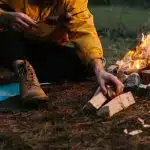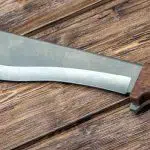Are you looking to get started with the best bushcraft projects for beginners? There are plenty of exciting activities that’ll help you become more familiar with the outdoors. Equipped with the right tools and understanding, these bushcraft projects can be both a stimulating and gratifying experience for beginners.
So, why not take the first steps to learn how to survive in nature by mastering some basic skills? This survival guide has everything you need to learn whether it’s building a fire, setting up camp shelters, or making natural rope and cordage. Let’s get crafting!
Building a Fire

Building a fire is an essential skill that most bushcrafters learn. Here’s the simplest way to do it.
Gathering Materials
Whether you’re a seasoned outdoor enthusiast or learning survival skills, gathering the correct materials is key to building a fire. You’ll need material for kindling, larger pieces of wood, and a fire starter. Kindling and tinder are anything similar to small twigs, dried leaves, sticks, or grass.
It’s also highly recommended to carry a kit with basic tools like a knife, saw, and axe. This will come in handy if you need to craft additional tools or make animal traps.
Building the Fire Structure
Once you have all your materials gathered, it’s time to start constructing your fire structure. The most common way is called “teepee style.”
That’s where you arrange smaller pieces of kindling into a cone shape with an opening at the top. Place your larger logs around that going from smallest on the inside to bigger on the outside. This allows air flow which lets the fire burn hotter and longer than if stacked flatly.
Light up the teepee structure. Once you have it constructed, ignite it using your fire starter of choice. That could be striking matchsticks against their box or flicking lighters until they spark. Place them near your tinder material which should catch alight quickly when exposed to heat.
To keep it burning brightly, add more fuel periodically while being careful not to stifle it. This is known as stoking the fire. Keep in mind, ashes and dirt can impede oxygen flow needed for combustion.
Ensuring the blaze continues to burn is essential once it’s ignited. Next, you’ll want to focus on putting a shelter together. Setting up a campsite shelter can protect you from the elements and give you peace of mind while enjoying that fire.
Setting Up Campsite Shelters

Setting up a campsite shelter is one of the essential bushcraft projects that all beginners should master. You can easily practice building shelters in the great outdoors (or your backyard) with the right tools and materials.
Look for a place with abundant small twigs or branches to aid in your shelter’s construction. You may want to create some basic tools like a knife or saw if you didn’t bring any. Try making animal traps out of natural materials, too, if you’re feeling adventurous.
Forming the shelter necessitates more than just collecting twigs. It’s essential to guarantee everything is steady and strongly supported. You don’t want it to cave in when faced with wind or rain.
For starters, build two A-frame structures using long logs. Tie them together at the top with rope made from natural fibers like jute or hemp (or use paracord if available). Fill in any gaps between logs with smaller twigs and branches until everything is securely held together.
Finally, cover the entire frame with leaves or other vegetation for added insulation against cold temperatures at night.
For the outdoor enthusiast, having an aid kit ready while setting up camp is a must. This kit should include items such as matches and fire starter kits for quick access to firewood. You’ll also want extra clothing layers if it becomes cold, first aid supplies, flashlights, and more.
Practice building shelters often. This practice will help hone your bushcraft skills and give you peace of mind knowing how easy (or difficult) it is to find adequate resources in different environments during emergencies. Don’t wait until disaster strikes. Get out there now and start learning these crucial survival skills.
Having chosen the materials and assembled your shelter, it’s now time to ensure it’s a cozy abode. Scouting for food and water can guarantee you stay alive in the wild.
Foraging for Food and Water Sources

Scavenging for sustenance and hydration in the outdoors can be a challenge. Yet with the proper know-how and equipment, it’s doable. Identifying edible plants is essential to ensure the safe consumption of natural resources.
And it helps you avoid potential risks such as poisoning or allergies. Having correct information and tools (like a backpack) can be critical to a successful foraging experience.
When looking for edible plants, there are key indicators to watch out for, including leaf shape, color, texture, smell, taste, and other distinguishing characteristics. Common berries in North America are easily identified by their unique shapes and colors.
It’s important to remember that not all plants are edible. Some may even be poisonous, so extra caution should be taken when trying something new. It’s better to be cautious and not consume a plant if there’s any doubt about its edibility.
Be aware of signs of contamination from nearby animal waste products or industrial runoff. This pollutant could potentially lead to illness if ingested without proper treatment.
Overall, foraging requires some research beforehand and practice over time. Don’t be disheartened if you don’t find success immediately. With enough dedication and effort, you’ll become more comfortable identifying edible plants/berries and definite clean water sources.
By honing your foraging skills, you can become more self-sufficient and equip yourself with the crucial tools to thrive outdoors. With this knowledge, you’re ready to move on to making natural rope and cordage.
Making Natural Rope and Cordage
When making natural rope and cordage, you’ll need some fibrous materials. Plant fibers like yucca, milkweed, cattail, or dogbane are good alternatives for collected materials.
To collect them correctly, you should look for mature plants that have been sun-dried. Strip the fibers from the plant’s stalks with your hands or a knife. Once you have enough of the fibrous materials, turn them into something useful by twisting, braiding, or weaving.
Twisting is one of the simplest methods used to make natural rope or cordage. All you need is two strands of material that can be held in each hand. You twist them around each other until they become tight and form a strong bond.
Braiding is another popular method. It involves three strands being woven together over and under each other in an alternating pattern. This technique creates a thicker piece of rope than if it were just twisted alone.
Lastly, consider weaving. Weaving requires more skill but produces sturdier pieces due to its interlocking patterns. It’s created by four strands weaved over and under each other in multiple directions simultaneously.
No matter what technique you use when making natural rope or cordage, always remember: safety first. Ensure any tools used are adequately sharp and don’t snag on the material. But not so keen where they could cause injury.
This rule includes knives when cutting down plants for collecting and scissors when trimming off excess fibers after braiding or weaving. Additionally, wear protective gloves since many plant fibers can irritate the skin upon contact. Taking proper precautions will help ensure everyone stays safe during the process.
FAQs
Don’t worry if you didn’t find the answers you were looking for up there. Here are the most frequently asked questions related to bushcraft.
What is the easiest bushcraft?
Bushcraft practice involves using natural resources to survive and thrive in a wilderness environment. One of the least challenging bushcraft skills is fire-building.
This skill involves gathering dry tinder, kindling, and fuelwood and creating an ignition source such as flint or steel for sparks.
Once you’ve gathered these elements, it’s just a matter of stacking them correctly and building up the heat until you have a roaring blaze that will keep you warm throughout the night. With patience and practice, anyone can master this skill with ease.
What are the basics of bushcraft?
It involves skills such as shelter building, fire making, water procurement, food preparation and storage, navigation, and signaling for help.
Bushcraft also includes knowledge about plants and animals used for sustenance or medicinal purposes. All of these skills require practice to master but are essential when faced with an unexpected situation while outdoors.
What is the difference between bushcraft and survival?
Bushcraft involves learning how to identify edible plants, make natural tools for hunting game animals, and build fires without matches or lighters – by using friction techniques like bow and hand drills.
Survival focuses more on short-term emergencies where you must stay alive until help arrives. This skill includes knowing how to find safe drinking water sources in an unfamiliar environment; building shelters quickly with minimal materials; signaling for help; identifying dangerous wildlife; or finding ways out of a hostile area safely.
What is bushcraft activity?
Bushcraft includes many outdoor activities. These include building shelters, making fire without matches, finding edible plants and water sources, navigating with a map or compass, tracking animals, and using tools such as knives for cutting wood or rope.
Bushcraft teaches us to live off the land while respecting natural resources. By honing our bushcraft skills, we can gain invaluable insight into the natural world and become more conscientious guardians of its wild areas.
Conclusion
Some good bushcraft projects for beginners are an excellent way to hone outdoor survival skills. These projects can help build confidence and increase your knowledge of the natural environment.
Fire building, shelter construction, foraging for food and water sources, making rope and cordage – all these activities will teach you valuable lessons in self-reliance that may come in handy someday. With some practice, patience, and this survival guide, anyone can become proficient at basic bushcraft techniques.




